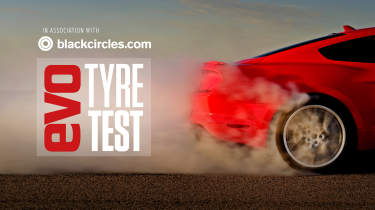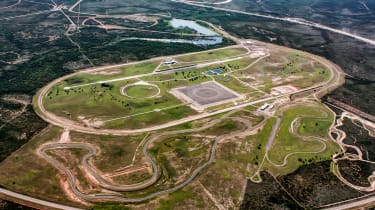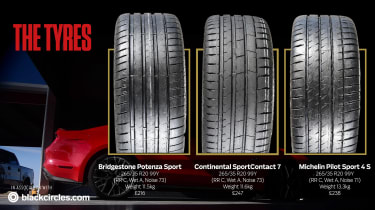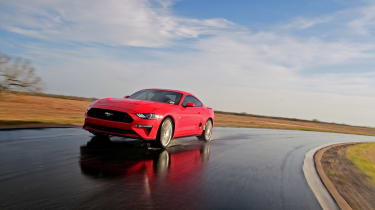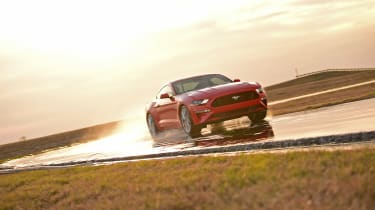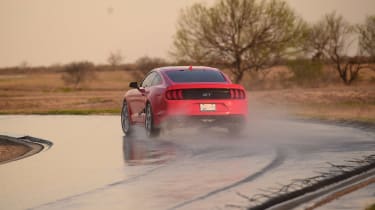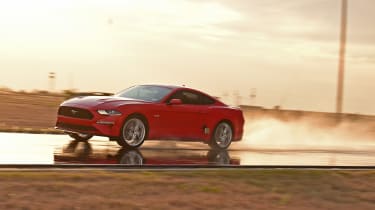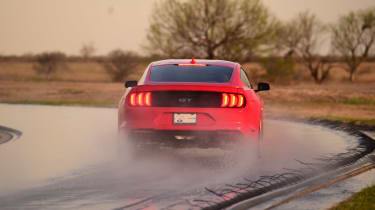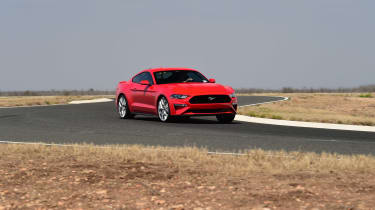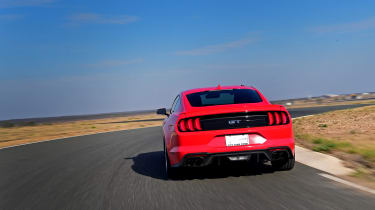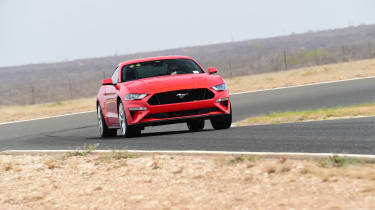Continental SportContact 7 vs rivals: tyre test review
We pitch Continental's new SportContact 7 against rivals from Michelin and Bridgestone to find which is the best ultra high performance tyre
Last summer we attended the launch of the Continental SportContact 7, a brand new, Ultra High Performance (UHP) tyre that came with some very bold claims. We were able to put its performance to the test in a number of disciplines, including dry handling and braking, and wet handling, where we tested the new tyre against the tyre it was replacing, the SportContact 6, on the same car. The new tyre delivered very impressive results, but how would it perform against a couple of its keenest rivals, we wondered.
This is where we get our first chance to find out. We took the SportContact 7, the Michelin Pilot Sport 4 S (winner of our 2020 test) and the impressive new Bridgestone Potenza Sport (third in our 2021 test) and put them through our full tyre test programme.
> Click here for the latest UHP tyre offers at Black Circles.com
To ensure good weather, we used Continental’s proving ground in Uvalde, Texas, and rather than use a front-drive fast hatch as we often do, we took the opportunity to test a larger tyre size on a big, powerful, rear-drive car – the 265/35 R20 on a 460bhp Ford Mustang GT.
The car
In our annual tyre tests we pick a common tyre size and usually employ a front-drive hatchback as the test vehicle. For this mini-test we chose a bigger, 20-inch tyre so we could use a powerful, rear-drive car. The Ford Mustang GT weighs just shy of 1700kg and in 21MY US spec its 5-litre V8 develops 460bhp and 420lb ft of torque, which it delivers via a six-speed manual gearbox and a Torsen limited slip diff. It’s not the most communicative car in terms of steering feel but it makes demands that leave the tyres nowhere to hide, especially on the wet handling circuit.
The track
The Uvalde proving ground in Texas is a vast, 5000-acre facility that offers hot-weather testing for much of the year. An outer oval of 8.5 miles (see page 120) surrounds the paved tracks we used, but a few of the many off-road courses lie beyond it. It was built by the General Tire company, and in 1987 was acquired by Continental, which built a near-replica of the wet handling track from its Hannover proving ground. More recently it has built a new 1.8-mile dry handling circuit featuring elevation changes and sections inspired by the Nürburgring.
The tyres
- Our test tyres were sourced by an independent buyer from the wholesale market.
- Prices shown are averages deduced from a number of suppliers.
- EU tyre label ratings are shown in brackets: RR = rolling resistance, on a scale from A (best) to E (worst); a tyre with a better rating should deliver better fuel economy.
- Wet = wet grip, also on a scale from A to E; this EU rating focuses solely on wet braking performance.
- Noise = the exterior noise generated by a tyre, measured in decibels; quieter tyres generate between 67 and 71 dB, louder tyres up to 77 dB.
Wet handling
The wet handling track in Texas isn’t quite a copy of the one in Hannover, missing out a couple of turns on the return leg. The torque-rich Mustang easily managed the whole 1.535km in third gear, even the tightest corners. We used Sport mode with stability control off, trying to maximise speed but keep understeer or oversteer from escalating.
The Continental is devastatingly good, nailing an average lap time of 68.7sec, almost two seconds a lap faster than the Bridgestone and over two seconds a lap faster than the Michelin, and it feels like it. Its grip is on another level; you can nail the apex of every corner and even if it starts to slip, a little lift brings it back quickly. Neat and capable, it delivered a confident, exploitable performance.
The Bridgestone feels generally less grippy. It’s a little less keen to turn in and if you try to trail brake to help the nose in, the rear can get loose. It’s more adjustable but you seem to spend time waiting for the grip to reassert itself. In the faster turns, rear slip creeps up on you and is not entirely predictable, making it trickier to fully exploit.
The Michelin has strong front-end bite like the Continental and the adjustability of the Bridgestone, which sounds like a winning combination but it’s not borne out by the lap time. There’s a little more power oversteer available, which can be used to good effect in slower turns. However, on the Michelin (the car’s OE tyre) the Mustang’s tail was loose in the faster turns, like it wasn’t cutting through the water as effectively, which is why it finished just behind the Bridgestone, subjectively.
Wet handling – lap time
| Tyre | Seconds | % |
| Continental | 68.7 |
100 |
| Bridgestone | 70.5 |
97.4 |
| Michelin | 71.1 |
96.6 |
Wet handling – subjective
| Tyre | Points | % |
| Continental | 55.0 | 100 |
| Bridgestone | 47.5 | 87.2 |
| Michelin | 46.5 | 85.3 |
Wet circle
As expected, the finishing order around the round the wet asphalt circle (inside diameter 58m) was the same as on the wet handling circuit, although the results for this test of outright grip were much closer. The Mustang felt like a big, hefty thing but was surprisingly neutral and generated strong grip on all three test tyres. The Continental set the standard, topping the table with an average of 11.5sec, just a tenth ahead of the Bridgestone, which was itself a mere tenth ahead of the Michelin.
Wet cornering
| Tyre | Points | % |
| Continental | 11.5 | 100 |
| Bridgestone | 11.6 | 98.7 |
| Michelin | 11.7 | 98.5 |
Aquaplaning
On the wet handling circuit there was a sense that the Michelin was less able to maintain grip in the faster corners, so it’s no surprise that it finished third in the lateral aquaplaning test, which averages the residual lateral acceleration measured at a number of speeds between 60 and 90kph (37-56mph) in 5mm of water. The surprise is that the Continental is only fractionally better than the Michelin.
The standout performance came from the Bridgestone, which made it an aquaplaning clean sweep. It recorded the strongest resistance to longitudinal aquaplaning too, though by a lesser margin, this test conducted in 9mm of water and measuring the speed the tyre can attain before it over-speeds by 15 per cent. As in the curved test, Continental was second and Michelin third.
Curved aquaplaning
| Tyre | Residual accel | % |
| Bridgestone | 3.09 | 100 |
| Continental | 2.72 | 88.0 |
| Michelin | 2.48 | 80.3 |
Straight line aquaplaning
| Tyre | Max kph | % |
| Bridgestone | 90.8 | 100 |
| Continental | 89.1 | 98.1 |
| Michelin | 87.1 | 96.0 |
Braking and rolling resistance
All three tyres are rated ‘A’ for wet grip – the best – and the Bridgestone and Michelin performed well, hauling down from 80kph (50mph) to zero in 34.9 and 35.7m respectively. However, the Continental was in a different league, averaging just 31.9m and bettering the Bridgestone by a full three metres, which is an astonishing amount.
The Continental set the standard in the dry braking test, too, though not as emphatically. Stopping from 100kph (62mph) to zero on warm asphalt took it 33.8m, pipping the second-placed Michelin by just half a metre. The Bridgestone was decent but at 35.8m was a full 2m off the Continental.
For rolling resistance, all three tyres are declared in band ‘C’, the mid-point in the EU labelling, and our tests correlate that. The best tyre is the Michelin, which is at the lower end of the band, while the Bridgestone and Continental are close to the middle of the range.
Wet braking
| Tyre | Meters | % |
| Continental | 31.9 | 100 |
| Bridgestone | 34.9 | 90.5 |
| Michelin | 35.7 |
88.0 |
Dry braking
| Tyre | Meters | % |
| Continental | 33.8 | 100 |
| Michelin | 34.3 | 98.5 |
| Bridgestone | 35.8 | 93.9 |
Dry handling
All three tyres returned very similar lap times over the selected 2.6km (1.6‑mile) section of dry handling circuit, yet they were quite different in character.
The Continental felt strong and accurate, gripping well, changing direction confidently and, given just a moment to settle, hooking into every apex. It was the front end that slipped wide at the limit but it would still take decent throttle, while through the fastest curves and cambers it was the most poised. It was rated best subjectively. The surprise was that its lap was a mere 0.2sec faster than the Bridgestone and 0.4sec faster than the Michelin.
The Michelin was marginally preferred over the Bridgestone. It took a little longer to settle than the others but offered a little more rotation, which was useful into and out of the tighter corners. It felt a bit loose through faster turns but was predictable and exploitable. A rewarding tyre to get the best from. The Bridgestone performed well too, offering a bit more bite than the Michelin and a touch more adjustability than the Continental, though understeer was a little dogged, so it didn’t feel as willing.
Dry handling – lap time
| Tyre | Seconds | % |
| Continental | 78.6 | 100 |
| Bridgestone | 78.8 | 99.7 |
| Michelin | 79.0 | 99.5 |
Dry handling – subjective
| Tyre | Points | % |
| Continental | 60.5 | 100 |
| Michelin | 55.0 | 90.9 |
| Bridgestone | 53.5 | 88.4 |
Road route
Michelin just pips Continental in terms of on-road feel thanks to its superior steering connection, which is there from low speed – an area where this tyre often excels. The Mustang’s steering is far from the most tactile but the Michelin still gives it a brightness and response that’s initially lacking with the others. It backs this up with an ability to soak up bumps and tricky surfaces quietly, being troubled only by expansion joints.
The Continental was a close second. It deals with raised and sunken bumps with a similar solid assurance to the Michelin while softening the sting and noise of sharper events more effectively. It offers direct, slack-free steering response from around 50mph-plus, too. The Bridgestone also performs well, with good directness and steering connection like the Continental, scoring fractionally less overall only because it comes with higher general noise on some coarse surfaces and feels busier over shallow potholes and raised manhole covers.
Road route
| Tyre | Meters | % |
| Michelin | 25.0 | 100 |
| Continental | 24.0 | 96.0 |
| Bridgestone | 20.5 | 82.0 |
Results
3rd Bridgestone 92.6
A strong performance by the Potenza Sport, third place reflecting only that rival Continental has set new standards. The Bridgestone topped the aquaplaning tables and showed little in the way of weaknesses. It lacks only some noise refinement.
Blackcircles says… Since its 2021 launch, this model has received high ratings – with an overall score of 4.8/5 from Blackcircles.com customers. Reviews praise the overall performance, especially its grip and balance in dry conditions.
2nd Michelin 94.4
A great tyre that delivers solid results in all the disciplines, the Pilot Sport 4 S also sets the standard in feel thanks to great steering connection and an innate adjustability. It lags a little in wet performance, but its replacement is imminent.
Blackcircles says… This tyre is consistently a firm favourite with Blackcircles.com customers – more than 2700 reviews have given it an overall score of 4.7/5. Customers frequently praise the tyre’s handling, comfort and durability.
1st Continental 98.4
A very impressive performance by the SportContact 7, which came close to a clean sweep. It nailed all the big tests – wet and dry handling and wet and dry braking – and wasn’t far off the pace in the others. Fit a set and instantly improve your car’s performance.
Blackcircles says… Successor to the popular SportContact 6 – which over 220 Blackcircles.com customers have rated 4.6/5 overall – this new tyre seems destined to build upon its predecessor’s strong reputation for performance.

